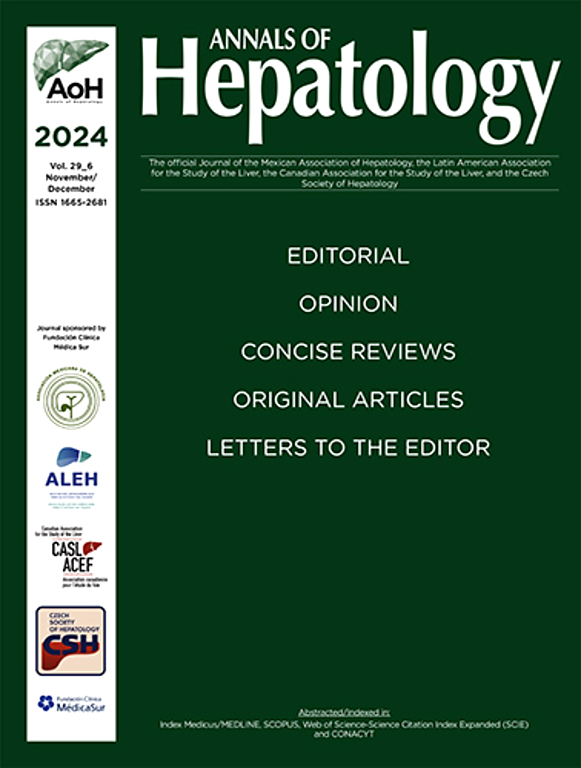Characterizing outcomes in a large cohort of latinx patients with autoimmune hepatitis
IF 4.4
3区 医学
Q2 GASTROENTEROLOGY & HEPATOLOGY
引用次数: 0
Abstract
Introduction and Objectives
This study aimed to characterize a large cohort of Latinx patients with autoimmune hepatitis (AIH) and analyze clinical outcomes, including biochemical remission, duration of steroid treatment, fibrosis regression, and incidence of clinical endpoints (hepatic decompensation, need for liver transplant, and death).
Materials and Methods
This was a retrospective descriptive study of patients with biopsy proven AIH (2009–2019) at a single urban center. Demographics, medical comorbidities, histology, treatment course, biochemical markers, fibrosis using dynamic non-invasive testing (NIT), and clinical outcomes at three months and at one, two, and three years were analyzed.
Results
121 adult patients with biopsy-proven AIH were included: 43 Latinx (35.5%) and 78 non-Latinx (65.5%). Latinx patients were more likely to have metabolic dysfunction-associated steatotic liver disease (MASLD) (p = 0.004), and had higher Fibrosis-4 (FIB-4) (p = 0.0279) and AST-to-Platelet-Ratio-Index (APRI) (p = 0.005) at one year. Latinx patients took longer to reach biochemical remission than non-Hispanic Whites (p = 0.031) and longer to stop steroids than non-Hispanic Blacks (p = 0.016). There were no significant differences based on ethnicity in histological fibrosis stage at presentation or incidence of clinical endpoints.
Conclusions
MASLD overlap is highly prevalent in Latinx AIH patients. Longer time to biochemical remission and worse NITs support that this population may have slower fibrosis regression with standard of care AIH treatment. This may indicate differing response rates due to genetic polymorphisms affecting drug metabolism and immune response among Latinx individuals and is less likely related to AIH/MASLD overlap based on the findings of this study.
大型拉丁裔自体免疫性肝炎患者群体的治疗效果特征。
简介和目标:本研究旨在描述一大批拉丁裔自身免疫性肝炎(AIH)患者的特征,并分析临床结果,包括生化缓解、类固醇治疗持续时间、纤维化消退以及临床终点(肝功能失代偿、肝移植需求和死亡)的发生率:这是一项回顾性描述性研究,研究对象是一家城市中心的活检证实的 AIH 患者(2009-2019 年)。研究分析了患者的人口统计学特征、合并症、组织学、治疗过程、生化指标、使用动态无创检测(NIT)的肝纤维化以及三个月、一年、两年和三年的临床结果:共纳入 121 名经活检证实的 AIH 成年患者:结果:共纳入 121 名经活检证实的 AIH 成人患者:43 名拉丁裔(35.5%)和 78 名非拉丁裔(65.5%)。拉丁裔患者更有可能患有代谢功能障碍相关性脂肪性肝病(MASLD)(p = 0.004),一年后纤维化-4(FIB-4)(p = 0.0279)和谷草转氨酶与血小板比率指数(APRI)(p = 0.005)更高。拉丁裔患者达到生化缓解的时间比非西班牙裔白人长(p = 0.031),停用类固醇的时间比非西班牙裔黑人长(p = 0.016)。在发病时的组织学纤维化阶段或临床终点的发生率方面,不同种族之间没有明显差异:结论:MASLD重叠在拉丁裔AIH患者中非常普遍。较长的生化缓解时间和较差的NITs表明,该人群在接受AIH标准治疗后,纤维化消退的速度可能较慢。这可能表明拉美裔个体中影响药物代谢和免疫反应的基因多态性导致了不同的反应率,而根据本研究的结果,这与AIH/MASLD重叠的可能性较小。
本文章由计算机程序翻译,如有差异,请以英文原文为准。
求助全文
约1分钟内获得全文
求助全文
来源期刊

Annals of hepatology
医学-胃肠肝病学
CiteScore
7.90
自引率
2.60%
发文量
183
审稿时长
4-8 weeks
期刊介绍:
Annals of Hepatology publishes original research on the biology and diseases of the liver in both humans and experimental models. Contributions may be submitted as regular articles. The journal also publishes concise reviews of both basic and clinical topics.
 求助内容:
求助内容: 应助结果提醒方式:
应助结果提醒方式:


